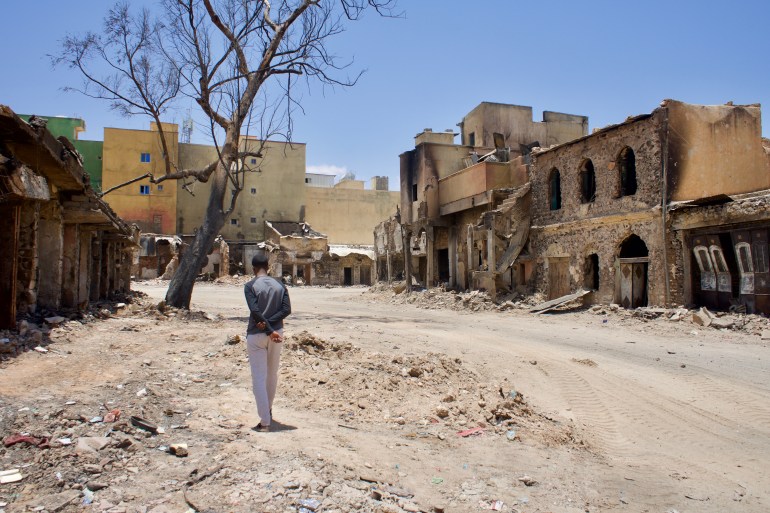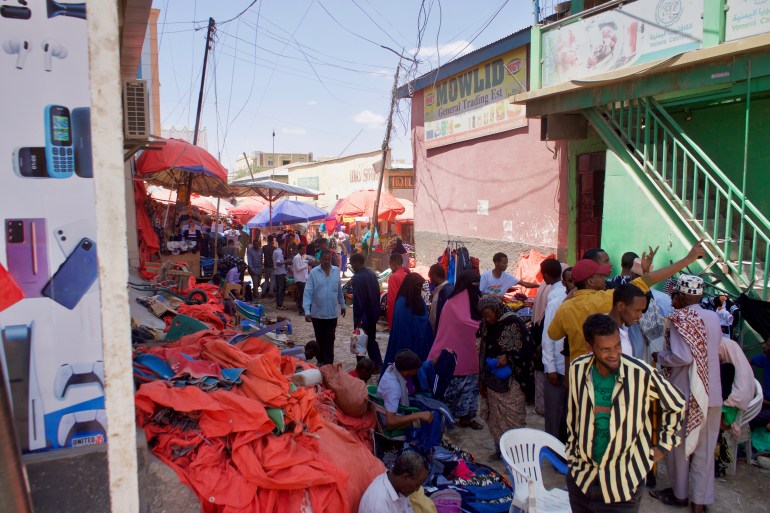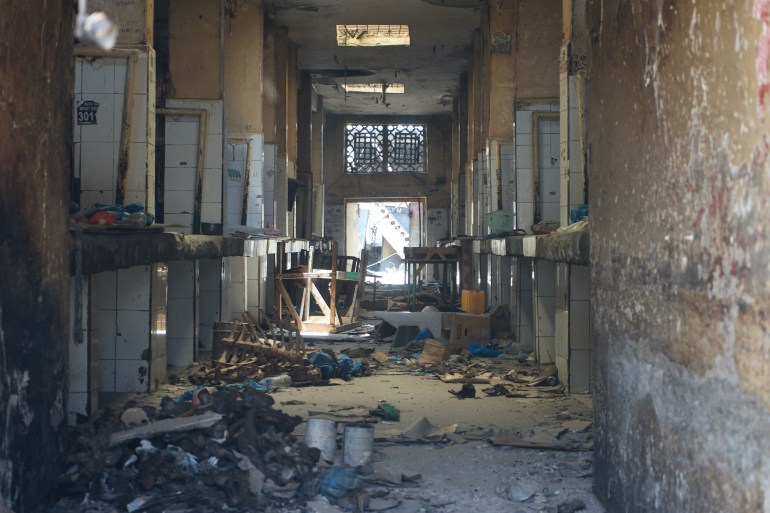Residents and traders say the market in Hargeisa was an entire financial district and pivotal to Somaliland’s economy.

A man walks through the destroyed Waheen Market, epicentre of commercial activity in the unrecognised de facto state of Somaliland
[File: Edward Cavanough/Al Jazeera]
By Edward Cavanough
Published On 26 Apr 2022
Hargeisa, Somaliland: On April 1, the first night of Ramadan, 23-year-old Somalilander Abdul Rahman was undertaking a solemn duty.
A friend’s relative had recently passed away, and Rahman was helping dig the grave. As he toiled in a graveyard on the outskirts of Hargeisa, the capital of the unrecognised de facto state of Somaliland, his phone lit up.
News of a major fire in the Waheen Market, a sprawling bazaar that employed more than 12,000 Somalilanders, was circulating widely on social media. As the owner of a clothing stall in the market, Rahman raced to the scene.
“We were in the graveyard, and we ran 3 kilometres to the fire. All the streets were blocked by cars,” he said. When he arrived, he found the market engulfed in flames. “I worked with the firefighters to remove the stock,” Rahman said. “It was very dangerous.”
About 300 metres (1,000 feet) away, former Somaliland head of mission to the United Kingdom, Ayan Mahamoud, was dining at the Damal Hotel. “We [first] thought it was a small fire. And just five to 10 minutes [later], we saw the fire literally in the sky,” said Mahamoud.
“The whole city was running,” she said. “At some point, we thought we’re all going to die.”

Traders have set up shop on adjacent streets, blocking traffic after the Waheen market fire in Somaliland.
[File: Edward Cavanough/Al Jazeera]
Ruins and memories of ruins
Rahman showed Al Jazeera a photo of what remained of the family business founded by his father in 2006, which directly supported 20 people. It was destroyed.
Access to the market site has been restricted as the clean-up operation commences.
Three weeks after the blaze was brought under control, smoke continued to billow from one pile of rubble. Ottoman buildings dating back to the 19th century are crumbling. Twisted sheets of corrugated iron are scattered across the site. Stock is charred and left in place, and the air remains thick with smoke and dust.
A single tree that once provided shade for Somalilanders in the open-air section of the market still stands, but is now blackened and stripped of foliage.
While no deaths were reported — the fire broke out after the market had closed — the sheer scale of the blaze has scarred Somaliland, economically and emotionally.
Authorities have estimated the economic impact of the fire at $2bn, or 60 percent of Somaliland’s gross domestic product (GDP). The astronomical figure is due to the market’s centrality to Somaliland’s economy.
Much of the trade that flowed through the de facto state ended up for sale at the Waheen. “It was more than a market, it was an entire financial district,” said Mahamoud.
The disaster comes as Somaliland battles fierce drought conditions, which have devastated communities throughout the Horn of Africa. The United Nations estimates the drought has impacted over 800,000 people in Somaliland, and in February, it stressed the need for “urgent humanitarian support” for those affected.
For some Somalilanders, the devastating scene of the destroyed Waheen Market brings back painful memories of the Somali civil war.
Between 1987 and 1989, more than 200,000 Isaaq tribespeople were killed in what has been described as Africa’s “forgotten genocide”. Much of the killing occurred in Hargeisa, which was also largely destroyed by the then-Somali government’s air raids.
Across the city, the fire is now being viewed as its second-biggest disaster. A lot of the traders were “that generation who left” Somaliland due to the genocide, Mahamoud said.
“They are saying ‘we’ve rebuilt once, we will do it again’. You just feel their lives have been taken away again from them,” she said.
Political hurdles
Three decades after declaring independence from Somalia, Somaliland bears the hallmarks of a legitimate independent state. It has sovereign control of its borders, issues its own currency, maintains a foreign service, and is run by a government elected through democratic processes.
But Somaliland is still considered an autonomous region within Somalia, with Mogadishu – and the rest of the world – continuing to reject Hargeisa’s claim.
Achieving international recognition is therefore one of the central objectives of the Somaliland government.
Before the fire, major efforts towards this goal were underway. A government delegation, led by President Muse Bihi Abdi, returned from the United States late in March, hopeful of a new era of engagement with Washington.
A port and road investment from the United Arab Emirates had strengthened Somaliland’s economic credentials and a new partnership with Taiwan had given Somaliland a useful diplomatic partner on the world stage.
The fire, however, has forced the Somaliland government to shift its attention towards recovery, which itself is being hampered by Hargeisa’s complicated political status.
In the days after the disaster, the international community pledged assistance.
“Your city will rise again and UK will do what we can to support Somaliand’s rebuilding effort,” Boris Johnson, the prime minister of the United Kingdom, tweeted after the fire.
But as an unrecognised state, foreign governments are unable to freely send money to Hargeisa, instead funnelling assistance through proxy NGOs which can slow disaster response.
Only Taiwan, which established a de facto embassy in Somaliland in 2020, has been able to directly contribute resources to the Somaliland government, pledging $500,000.

The ruins of the Waheen Market, Somaliland
[File: Edward Cavanough/Al Jazeera]
‘We saw all of our stock burn’
Within two weeks of the fire, the Somaliland government had identified almost 1,000 victims eligible for compensation. Initial estimates suggest 2,000 business owners were affected, though the true number is much higher given the prevalence of unregistered traders.
Shiran, who carted goods throughout the market on a wheelbarrow unregistered, was one of those who lost his livelihood. “We saw all of our stock burn,” he said, via a translator. “We are really asking for help”.
Abdi Shakur was another unregistered trader. “I lost almost $2,000. I lost everything,” he told Al Jazeera.
In the aftermath of the fire, displaced traders have camped on the surrounding streets, setting up new stalls on once busy thoroughfares, creating gridlock in downtown Hargeisa.
As Eid approaches, Hargeisa is adjusting to a new normal, with the economic and cultural heart of the Somaliland capital now only a memory.
But with food security in Somaliland already threatened by the ongoing drought, an emotional Mahamoud fears that economic impact of the Waheen fire could be the beginning of something worse.
“It’s one thing about how to recover economically,” she said. “It’s another to make sure people are not dying of hunger.”

© 2022 Al Jazeera Media Network



No comments:
Post a Comment